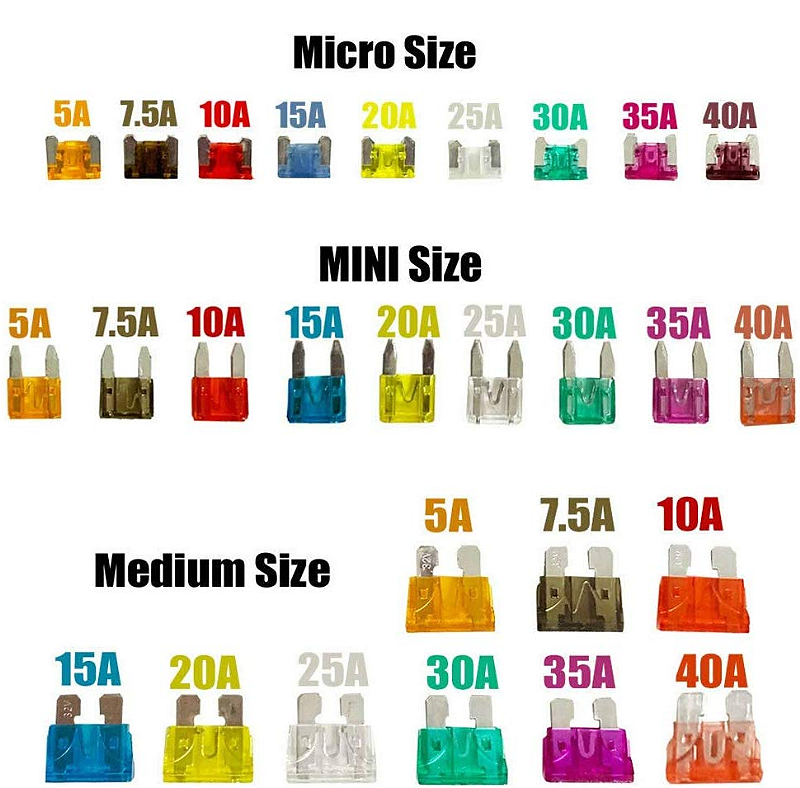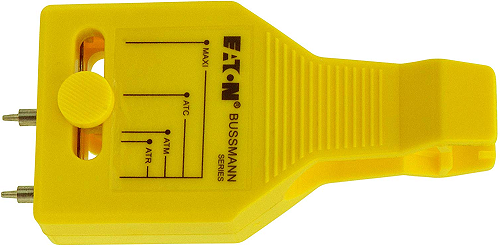Fuses protect your vehicle’s electrical system from overloading. If electrical parts in your vehicle are not working, the system may have been overloaded and blown a fuse. Before you replace or repair any electrical parts, check the appropriate fuses.
The following charts tell you which fuses protect each electrical part of your vehicle. If a fuse blows, all the parts of your vehicle that use that circuit will not work.
Once you have determined which fuses to check, follow the procedures under Checking and Replacing Fuses further down this page.
Passenger Compartment Fuse Panel
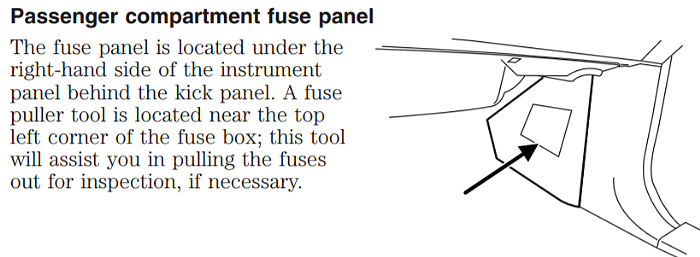
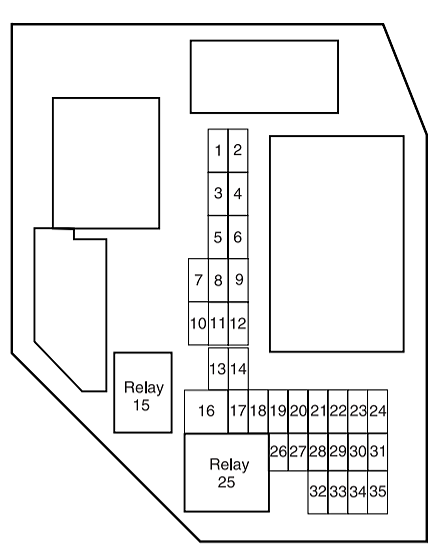
| No. | AMPS | Protected circuits |
| 1 | 5 | Instrument panel dimmer switch |
| 2 | 10 | Trailer tow park lamps |
| 3 | 10 | Right low beam headlamp |
| 4 | 10 | Left low beam headlamp |
| 5 | 30 | 2004-2007: Windshield wipers/washer |
| 5 | 2008-2012: Windshield wiper module (run/accy) | |
| 6 | 10 | Radio (RUN/ACCY), Door switch illumination (2008-2012) |
| 7 | 5 | 2004-2006: Headlamp illumination indicator |
| 8 | 10 | Restraints Control Module (RCM), PADI (Passenger Air bag Deactivation Indicator), Occupant classification sensor (OCS; 2007-2012) |
| 9 | 5 | Cluster air bag indicator |
| 10 | 10 | Cluster (RUN/START), 4×4 module (RUN/START) |
| 11 | 10 | Passenger compartment fuse panel (Logic power) |
| 12 | 15 | Center console subwoofer amplifier, Satellite radio |
| 13 | 15 | Horn, Interior lamps |
| 14 | 15 | High beam headlamp, High beam indicator (cluster) |
| 16 | 30 | Power windows |
| 17 | 15 | Turn signals/Hazards |
| 18 | — | Not used |
| 19 | 20 | Center High-Mounted Stop Lamp (CHMSL)/Stop lamps |
| 20 | 10 | Anti-lock Brake System (ABS) module, Brake-shift interlock (2004-2007), Speed control module, Back-up lamps, Overdrive cancel switch, Electronic flasher (turn/hazard) |
| 21 | 5 | Starter relay |
| 22 | 5 | Spare |
| 23 | 30 | Headlamps (low and high beam) |
| 24 | 20 | Radio |
| 26 | 2 | 2004-2006: Brake pressure switch 2007-2012: Redundant cruise switch |
| 27 | 10 | Climate control blower relay/blend doors, 4×4 module (2004-2006) |
| 28 | 15 | 4×4 module battery feed (B+) |
| 29 | 20 | Cigar lighter or power point, Diagnostic connector (OBD II) |
| 30 | 5 | Power mirrors |
| 31 | 20 | Front park lamps, Rear park lamps, License plate lamps, Dimmer switch, Trailer tow park lamps |
| 32 | 5 | Brake switch (logic) |
| 33 | 5 | Instrument cluster battery feed (B+) |
| 34 | 20 | Power point |
| 35 | 15 | Power locks |
| Relay | ||
| 15 | 2004-2007: One-touch down relay | |
| 25 | Accessory relay | |
Power Distribution Box
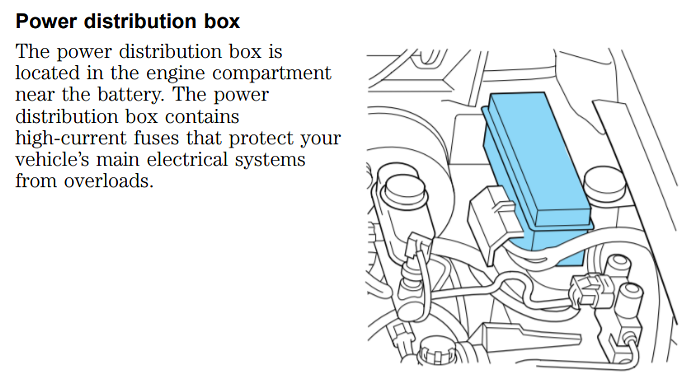
The power distribution box is located in the engine compartment on the drivers side near the fender.
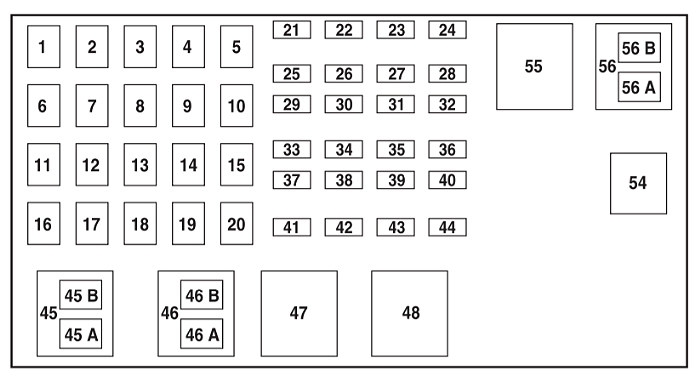
2.3L Engine (above)
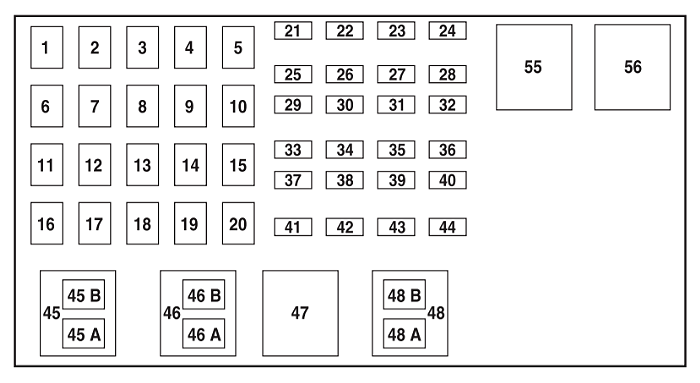
3.0L & 4.0L Engines (above)
| No. | AMP | Protected circuits |
| 1 | 50 | 2004: Passenger compartment fuse panel |
| 40 | 2005-2012: Passenger compartment fuse panel | |
| 2 | 40 | 2004-2007: Amplifier (Tremor audio system only) |
| 3 | 50 | 2004: Passenger compartment fuse panel |
| 40 | 2005-2012: Passenger compartment fuse panel | |
| 4 | — | Not Used |
| 5 | 50 | Passenger compartment fuse panel |
| 6 | — | Not Used |
| 7 | 40 | 2004-2007: Starter |
| 30 | 2008-2012: Starter | |
| 8 | — | Not Used |
| 9 | 40 | Ignition switch |
| 10 | — | Not Used |
| 11 | 30 | Powertrain Control Module (PCM), Engine sensors |
| 12 | — | Not Used |
| 13 | 30 | Blower motor (climate control) |
| 14 | — | Not Used |
| 15 | 30 | 2004: Anti-lock Brake System (ABS) (solenoids) |
| 16 | — | Not Used |
| 17 | 40 | ABS (motor) |
| 18 | — | Not Used |
| 19 | 20 | 2.3L engine: Engine fan |
| 20 | — | Not Used |
| 21 | 10 | PCM keep alive power, Canister purge valve solenoid (2007-2012) |
| 22 | — | Not Used |
| 23 | 20 | 2004-2006: Fuel pump |
| 30 | 2007-2012: Fuel pump motor, Fuel injectors | |
| 24 | — | Not Used |
| 25 | 10 | A/C clutch solenoid |
| 26 | — | Not Used |
| 27 | 20 | 4×4 module |
| 28 | — | Not Used |
| 29 | 30 | 2008-2012: Wipers/washer |
| 30 | — | Not Used |
| 31 | 15 | Fog lamps |
| 32 | 30 | 2005-2012: Anti-lock brake system (ABS) module |
| 33 | — | Not Used |
| 34 | — | Not Used |
| 35 | — | Not Used |
| 36 | — | Not Used |
| 37 | — | Not Used |
| 38 | 7.5 | Trailer tow (right turn) |
| 39 | 15 | 2007-2012: PCM power |
| 40 | — | Not Used |
| 41 | 15 | 2004-2006: Heated Exhaust Gas Oxygen (HEGO) sensors, EVAP canister vent valve, Exhaust Gas Recirculation (EGR) stepper motor, Transmission |
| 10 | 2007-2012: Automatic transmission | |
| 42 | 7.5 | Trailer tow (left turn) |
| 43 | 20 | 2007-2012: Engine fan relay coil, A/C relay coil, IAC, Mass air flow sensor, Heated exhaust gas oxygen sensor, Catalyst module sensor, Vapor management valve solenoid |
| 44 | 15 | 2007-2012: Ignition coil, Capacitor |
| Relay | ||
| 45A | 2004-2007: Wiper HI/LO relay | |
| 45B | 2004-2007: Wiper Park/Run relay | |
| 46A | 2004-2006 (2.3 L): Fuel pump relay 2007-2012 (2.3 L): Fuel pump relay, Fuel injectors relay 3.0L and 4.0L engines: A/C clutch solenoid |
|
| 46B | 2004-2007: Washer pump relay | |
| 47 | 2.3L engine: Engine fan relay 3.0L and 4.0L engines: PCM relay |
|
| 48 | 2.3L engine: Starter relay | |
| 48A | 2004-2006 (3.0 L, 4.0 L): Fuel pump relay 2007-2012 (3.0 L, 4.0 L): Fuel pump relay, Fuel injectors relay |
|
| 48B | 3.0L and 4.0L engines: Fog lamp relay | |
| 54 | Powertrain Control Module (PCM) relay | |
| 55 | Blower relay | |
| 56 | 3.0L and 4.0L engines: Starter relay | |
| 56A | 2.3L engine: A/C clutch solenoid relay | |
| 56B | 2.3L engine: Fog lamp relay | |
Checking and Replacing Fuses
If you need to check a fuse, follow these steps:
1. Find the fuse panel, which is located in the left end of the instrument panel. The power distribution box (described earlier in this section) is found in the engine compartment, mounted on a bracket attached to the drivers side fender apron.
To access the fuse panel, remove the fuse panel cover by inserting your finger in the divot and pulling on the cover. The underside of the cover contains four spare fuses. A fuse pulling tool is located in the lower right corner of the fuse panel in case you need to replace a blown fuse.
Color Coded: The spare fuses for your vehicle are color coded as follows:
- 10 amp — red
- 15 amp — light blue
- 20 amp — natural
- 30 amp — light green.
See further down on this page for examples
2. On the fuse panel cover, find the number of the fuse you want to check. The diagram on the cover tells you where to
locate the fuse on the panel.
3. Check the fuse to see if it is blown. Look through the clear side of the fuse to see if the metal wire inside is separated. If it is, the fuse is blown and should be replaced.
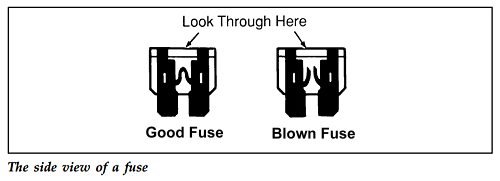
Another method for testing fuses is to use a Bussmann fuse tester. There’s no need to remove the fuse from the holder. You simply adjust the prong width on the tester to line up with the bare metal spots on the end of the fuse, and then watch for the indicator light to glow signaling that the fuse is good.
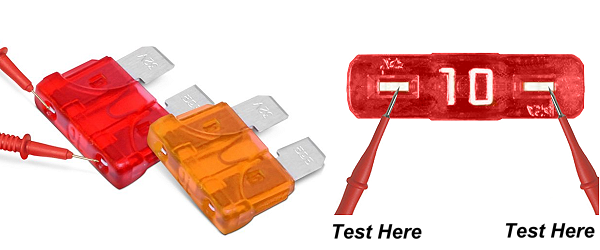
4. Replace the fuse with one that has the right amperage rating
*WARNING Always replace a fuse with one that has the specified amperage rating. Using a fuse with a higher amperage rating can cause severe wire damage and could start a fire.
5. Put the fuse panel cover back on.
Even after you replace a fuse, it will continue to blow if you do not find what caused the overload. If the fuse continues to blow, have your electrical system checked.
Fuse Color / Ratings:
As mentioned above, fuses are color coded to their AMP rating. See the image below for examples.
